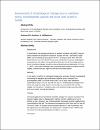Assessment of morphological changes due to oxidative stress: leukodepleted packed red blood cells stored in SAGM
| Author | Mustafa, Ibrahim |
| Author | Hadwan, Tameem |
| Author | Al Marwani, Asma |
| Available date | 2017-02-23T08:31:46Z |
| Publication Date | 2016-03-31 |
| Publication Name | CSTM Vancouver 2016 - Where Safety and Efficacy Meet - Conference Abstracts |
| Citation | Ibrahim Mustafa, Tameem Hadwan, Asma Al Marwani "Assessment of morphological changes due to oxidative stress: leukodepleted packed red blood cells stored in SAGM" CSTM Vancouver 2016 - Where Safety and Efficacy Meet - Conference Abstracts |
| Abstract | Background: In blood bank, the storage procedures of packed red blood cell (pRBC) require some conditions to ensure the maximum storage time for a safe blood supply. pRBC can be stored up to 42 days in 2-6⁰C, as long as more than 75% red blood cells survive in the first 24 hours post transfusion. However, pathological consequences can affect the stored blood, they are termed as storage lesions. Some reversible changes result from stored blood such as decreased ATP and 2, 3 BPG. Some other damages are irreversible and includes increased osmotic fragility, small echinocytic rigid red cells and microvesiculation. Methods: In this study, the effect of prolonged storage was assessed through investigating morphological alteration and evaluating oxidative stress.Samples from leukodepleted pRBC in SAGM stored at 4◦C for 42 days were withdrawn aseptically on day 0, day 14, day 28 and day 42. Morphological changes were observed using scanning electron microscopy and correlated with osmotic fragility and hematocrit. Oxidative injury was studied through assessing MDA level as a marker for lipid peroxidation. Results: Osmotic fragility test showed that extended storage time caused increase in the osmotic fragility. Day 42 displayed the highest osmotic fragility by the curve shifting to right. However, day 0 demonstrated the lowest osmotic fragility by the curve shifting to the left. The hematocrit increased by 6.6% from day 0 to day 42. The last 2 weeks of storage period revealed alteration in the morphology with the appearance of echinocytes and spherocytes. Small increase in MDA level was observed indicating that lipid peroxidation occurred. Conclusion: Storage lesions and morphological alterations appeared to affect RBCs during the storage period. These lesions are caused by oxidative injury, biochemical and metabolic changes that result in damaged RBCs membrane. Further studies should be performed to develop strategies that will aid in the improvement of stored RBC quality and efficiency. For example, the effect of ROS can be reduced by storing the blood bag in anaerobic condition. In addition, oxidative stress can be reduced by adding antioxidant in the blood bag. |
| Sponsor | Qatar University |
| Language | en |
| Publisher | Canadian Society of Transfusion Medicine |
| Subject | morphology oxidation Erythrocytes |
| Type | Conference Paper |
Files in this item
This item appears in the following Collection(s)
-
Biomedical Sciences [637 items ]


